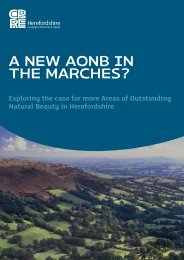Generating light on landscape impacts - Campaign to Protect Rural ...
Generating light on landscape impacts - Campaign to Protect Rural ...
Generating light on landscape impacts - Campaign to Protect Rural ...
- No tags were found...
Create successful ePaper yourself
Turn your PDF publications into a flip-book with our unique Google optimized e-Paper software.
Return <strong>to</strong> c<strong>on</strong>tentsDeveloping a strategic,plan-led approach910. We all have <strong>to</strong> make a c<strong>on</strong>tributi<strong>on</strong> <strong>to</strong> tackling climate change.Communities which are affected by renewable energy developments,including <strong>on</strong>shore wind, should have a choice about how their areac<strong>on</strong>tributes and which technologies should be used. This should beachieved through a planning system which is less c<strong>on</strong>fr<strong>on</strong>tati<strong>on</strong>al andinstead fosters engagement, co-operati<strong>on</strong> and respect, somethingCPRE has previously advocated in respect <strong>to</strong> renewable energy. 1311. At the heart of the problem lies the questi<strong>on</strong> of how our <strong>landscape</strong>scan accommodate necessary changes while retaining the characterwe value. Not all <strong>landscape</strong>s have the same value, although many thatare not classified as nati<strong>on</strong>ally important will nevertheless be of realimportance <strong>to</strong> people living within and close <strong>to</strong> them. Determining<strong>landscape</strong> value objectively requires an understanding of a <strong>landscape</strong>’scapacity and its sensitivity <strong>to</strong> change. These should be importantc<strong>on</strong>siderati<strong>on</strong>s when determining where <strong>on</strong>shore wind turbines shouldbe sited. Al<strong>on</strong>gside community engagement, <strong>landscape</strong> characterassessments are the most established way of determining capacityand sensitivity and therefore the relative ability of areas <strong>to</strong>accommodate wind energy development without unacceptableadverse <strong>impacts</strong>. 14Some regi<strong>on</strong>s andcounties are experiencingvery large numbersof applicati<strong>on</strong>s for<strong>on</strong>shore wind farmsand single turbines12. Regi<strong>on</strong>al Spatial Strategies, which will be revoked through theLocalism Act 2011, often used <strong>landscape</strong> character assessments whenallocating sub-regi<strong>on</strong>al targets. These helped <strong>to</strong> outline a <strong>landscape</strong>sensitivedistributi<strong>on</strong> of <strong>on</strong>shore wind across a regi<strong>on</strong>. This assistedlocal planning authorities in c<strong>on</strong>necting the Government’s nati<strong>on</strong>alrenewable energy strategy with local acti<strong>on</strong>, and required them <strong>to</strong>recognise <strong>landscape</strong> c<strong>on</strong>straints. Following the removal of the regi<strong>on</strong>alplanning tier, evidence <strong>on</strong> <strong>landscape</strong> capacity and its sensitivity <strong>to</strong>change is unlikely <strong>to</strong> be as comprehensive or up <strong>to</strong> date in future.13. As a result, the Department of Energy and Climate Change (DECC) hasattempted <strong>to</strong> develop new ways <strong>to</strong> determine the opportunities andc<strong>on</strong>straints for the deployment of renewable energy at a regi<strong>on</strong>al andlocal level. 15 This methodology represents a step in the right directi<strong>on</strong>but questi<strong>on</strong>s remain over whether the resulting reports are effectivelyinforming local level strategies. In Yorkshire and Humber, for example,the aim of the 2011 regi<strong>on</strong>al study 16 was <strong>to</strong> provide evidence thatcould be taken further at the local level. This has not happenedbecause it seems cash-strapped local authorities have been unable<strong>to</strong> c<strong>on</strong>duct the necessary local research.14. Without such a joined-up approach, some regi<strong>on</strong>s and counties areexperiencing very large numbers of applicati<strong>on</strong>s for <strong>on</strong>shore wind farmsand single turbines. These are having adverse cumulative <strong>impacts</strong>without any evidence of what scale of development can reas<strong>on</strong>ably beaccommodated in the <strong>landscape</strong>. The volume of applicati<strong>on</strong>s presentsa real challenge <strong>to</strong> local communities keen <strong>to</strong> ensure that eachapplicati<strong>on</strong> is scrutinised according <strong>to</strong> an overarching <strong>landscape</strong>assessment. While some <strong>landscape</strong>s are able <strong>to</strong> absorb <strong>on</strong>shore winddevelopment, others are highly sensitive <strong>to</strong> <strong>on</strong>e or multiple13CPRE, Nati<strong>on</strong>al Trust and RSPB, JointStatement <strong>on</strong> the UK Renewable EnergyStrategy, 200914CPRE, Unlocking the Landscape:Preparing a Community LandscapeCharacter Assessment, 200515SQW Energy and Land Use C<strong>on</strong>sultants,Renewable and Low-carb<strong>on</strong> EnergyCapacity Methodology: Methodology forthe English Regi<strong>on</strong>s, DECC, 201016Arup, North East Renewable CapacityStudy, One North East, 2011<str<strong>on</strong>g>Generating</str<strong>on</strong>g> <str<strong>on</strong>g>light</str<strong>on</strong>g> <strong>on</strong> <strong>landscape</strong> <strong>impacts</strong>: How <strong>to</strong> accommodate <strong>on</strong>shore wind while protecting the countryside




